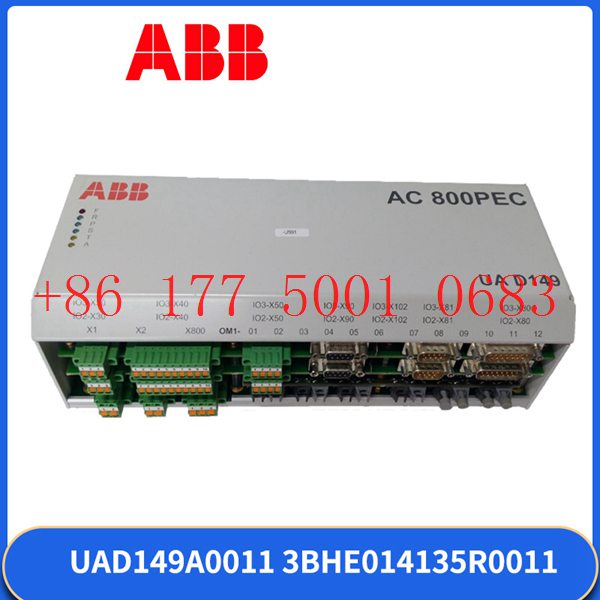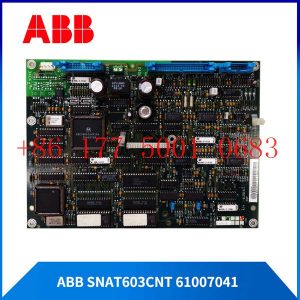Description
hardware flow control. It is an ideal choice in the field of industrial automation.
According to reports, ABB”s technical expertise and experience in many industries will be combined with Microsoft”s Azure intelligent cloud system and B2B
engineering capabilities to create greater value for customers. Combined with ABB”s more than 70 million connected devices installed globally and more than
70,000 running control systems, ABB and Microsoft will join forces to create one of the world”s largest IIoT industrial cloud platforms.
It is worth noting that IoT expert Guido Jouret (formerly general manager of Cisco’s IoT department) became the group’s chief digital officer on October 1, 2016.
This marks that ABB is accelerating digital transformation and comprehensively building a new “Internet of Things+” ecosystem. ABB also hopes to obtain higher
profits from this, and has proposed a financial target for 2015-2020 of pre-tax profit growth of 11%-16%.
FANUC
FANUC recently established the IoT platform Fanuc Intelligent Edge Link and Drive (FIELD), which uses NVIDIA artificial intelligence system. FIELD can realize the
connection of machine tools, robots, peripheral equipment and sensors in the automation system and provide advanced data analysis to improve the production quality,
efficiency, flexibility and equipment reliability in the production process – thereby improving the overall efficiency of the equipment ( OEE) and promote the improvement of production profits.
The system can also improve robot productivity through artificial intelligence and bring autonomous learning capabilities to automated factory robots around the
world. FANUC will use a series of GPUs and deep learning software designed and produced by NVIDIA to enable AI artificial intelligence to be used in clouds, data centers
and embedded devices.
When talking about the cooperation with FANUC, NVIDIA co-founder and CEO Jensen Huang said that the era of AI artificial intelligence has officially arrived.
Through the deep learning function of GPU, it will stimulate a
new wave of software learning and machine inference calculations. The most exciting of these is the ability of robots to understand their surroundings and
interact with humans. NVIDIA is very happy to work with FANUC, the global leader in automated factories and robots, to build intelligent machines to benefit the future of mankind.
It is reported that FIELD continues the success of the existing Fanuc ZDT (zero downtime function), which effectively combines Cisco cloud technology,
IoT data collection software and point-to-point security. After connecting the robot through the use of an industrial Ethernet switch, it is then connected to Cisco”s UCS server – the system runs
based on FANUC and Cisco”s ZDT data collection software. Automotive industry users can immediately realize reductions in downtime and cost savings after using the system.
FIELD provides users and application developers with advanced machine learning and artificial intelligence capabilities and brings manufacturing to
new heights of productivity and efficiency. Currently, FANUC has applied these new technologies to robotic bulk picking, production anomaly detection and fault
prediction. Because FIELD combines artificial intelligence and cutting-edge computer technology, distributed learning is possible. The operating data of robots and
equipment are processed in real time on the network,
which also enables more intelligent coordination of production between various equipment, making complex production coordination that was previously difficult to
achieve easily completed.
In fact, many years ago, FANUC began to cooperate with Cisco to carry out the “non-stop” zero downTIme plan. In the plan, FANUC and Cisco will join forces to
build an Internet of Things system that will allow FANUC to supervise
every robot in the factory, predict abnormal conditions of the robots, and send more technicians to repair the robots before problems occur. So far, the program has
tested 2,500 robots, including FANUC”s major customer GM General Motors. According to FANUC, the test program saved customers $38 million.
YASKAWA
After talking so much about the Internet of Things strategy of the industrial robot giant, let’s take a break here at Yaskawa and talk about the past.
Midea and KUKA have officially received their marriage certificates, but you must know that as early as August 2015, Midea announced its
robot strategy and established two joint venture subsidiaries with Japan”s Yaskawa Electric.
The two subsidiaries are respectively for industrial robots and service robots, including Guangdong Yaskawa Midea Industrial Robot Co.
, Ltd. (Midea”s equity accounted for 49%) and Guangdong Midea Yaskawa Service Robot Co., Ltd. (Midea”s equity accounted for 60%).
This shows that as early as 2015, Midea was actually “in love” with Yaskawa, but by 2016, she married Kuka.
Excitation system ABB module DSRF182AK02 3BSE014078R1
Excitation system ABB module DSRF182
Excitation system ABB module DSRF180M
Excitation system ABB module DSRF180A 57310255-AV
Excitation system ABB module DSRF180A
Excitation system ABB module DSRF160M
Excitation system ABB module DSRF160
Excitation system ABB module DSRF154M
Excitation system ABB module DSRF150
Excitation system ABB module DSRC113
Excitation system ABB module DSRB310
Excitation system ABB module DSRB110
Excitation system ABB module DSQT239
Excitation system ABB module DSQS118
Excitation system ABB module DSQC697
Excitation system ABB module DSQC697
Excitation system ABB module DSQC679 3HAC028357-001
Excitation system ABB module DSQC679 3HAC028357-001
Excitation system ABB module DSQC679
Excitation system ABB module DSQC679
Excitation system ABB module DSQC668 3HAC029157-001
Excitation system ABB module DSQC668
Excitation system ABB module DSQC664
Excitation system ABB module DSQC663 3HAC0298180881
Excitation system ABB module DSQC663 3HAC029818-001/14
Excitation system ABB module DSQC663 3HAC029818-001
Excitation system ABB module DSQC663
Excitation system ABB module DSQC661 3HAC026253-001
Excitation system ABB module DSQC661
Excitation system ABB module DSQC659
Excitation system ABB module DSQC658
Excitation system ABB module DSQC658
Excitation system ABB module DSQC653
Excitation system ABB module DSQC652 3HNA025917-001
Excitation system ABB module DSQC652
Excitation system ABB module DSQC651
Excitation system ABB module DSQC643 3HAC024488-001
Excitation system ABB module DSQC639 3HAC025097-001
Excitation system ABB module DSQC639
Excitation system ABB module DSQC639
Excitation system ABB module DSQC633
Excitation system ABB module DSQC627 3HAC020466-001
Excitation system ABB module DSQC627 3HAC020466-001
Excitation system ABB module DSQC627
Excitation system ABB module DSQC626A
Excitation system ABB module DSQC626
Excitation system ABB module DSQC626
Excitation system ABB module DSQC611
Excitation system ABB module DSQC611
Excitation system ABB module DSQC609
Excitation system ABB module DSQC609
Excitation system ABB module DSQC608
Excitation system ABB module DSQC608
Excitation system ABB module DSQC604
Excitation system ABB module DSQC604
Excitation system ABB module DSQC603
Excitation system ABB module DSQC602
Excitation system ABB module DSQC602
Excitation system ABB module DSQC601 3HAC12815-1
Excitation system ABB module DSQC601
Excitation system ABB module DSQC572
Excitation system ABB module DSQC562 3HAC16014-1/05
Excitation system ABB module DSQC546A
Excitation system ABB module DSQC545A 3HAB8101-19/07A









Reviews
There are no reviews yet.